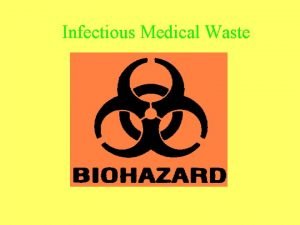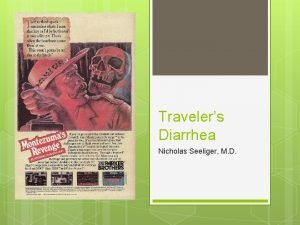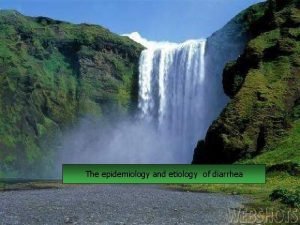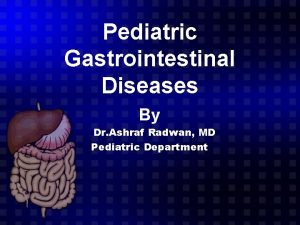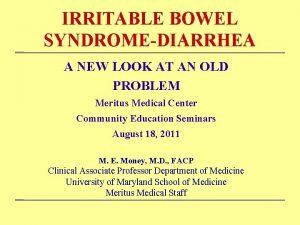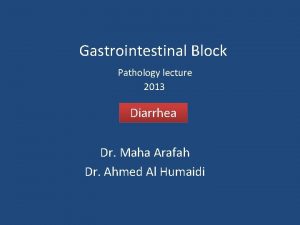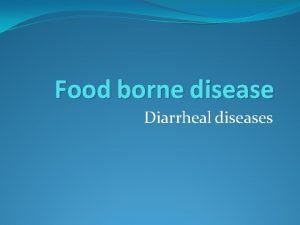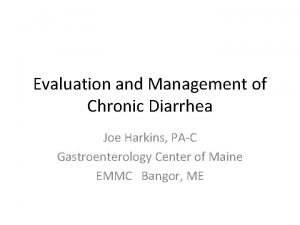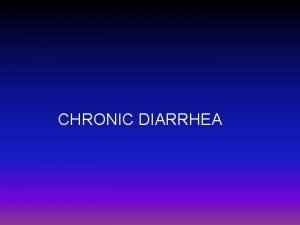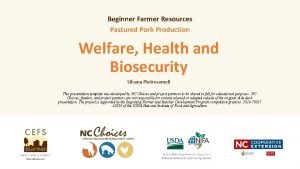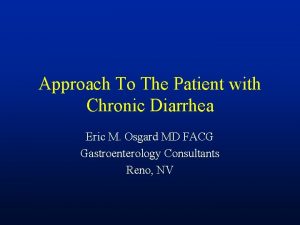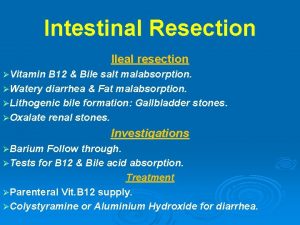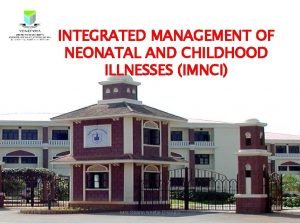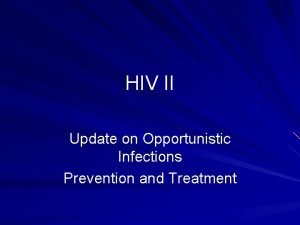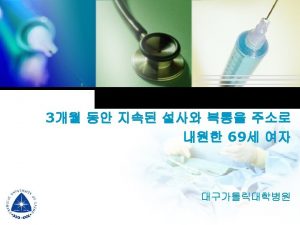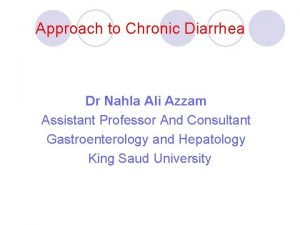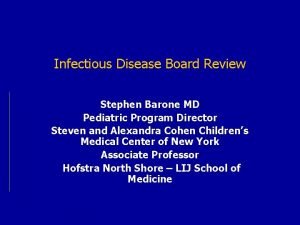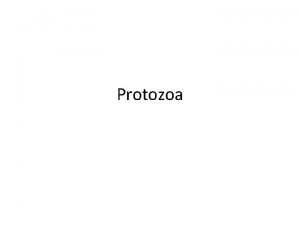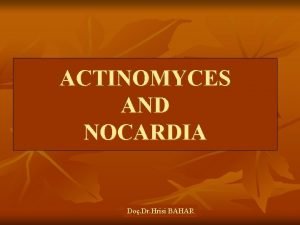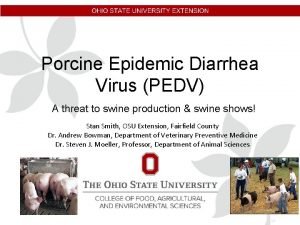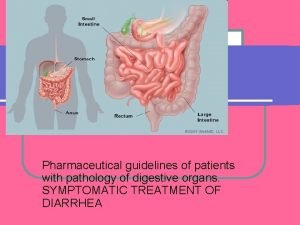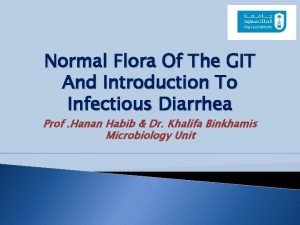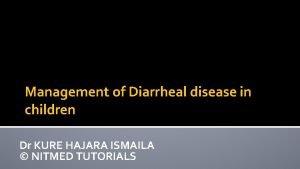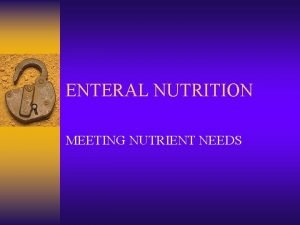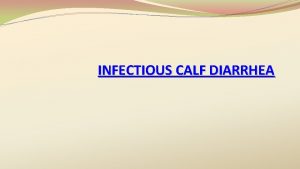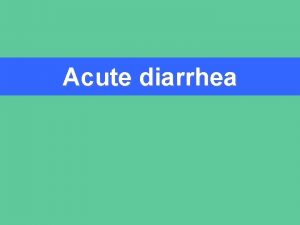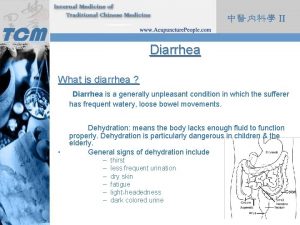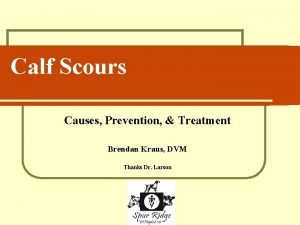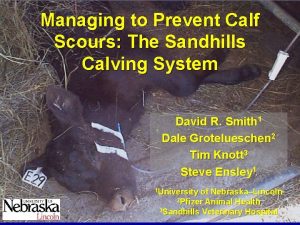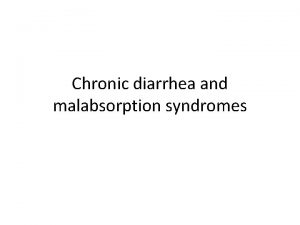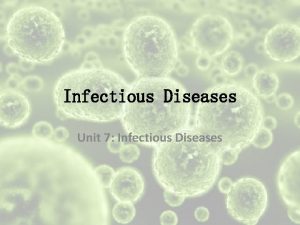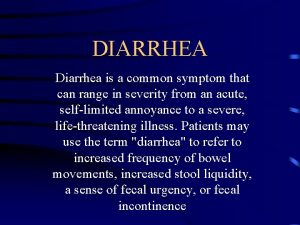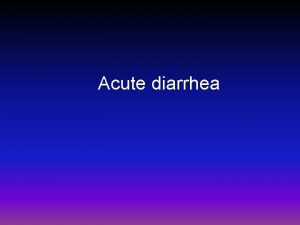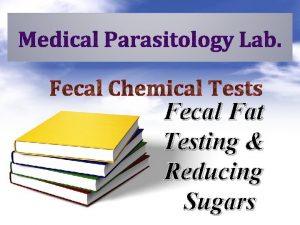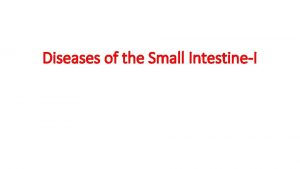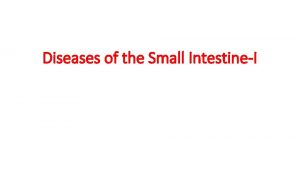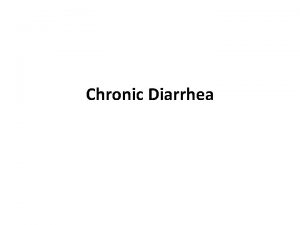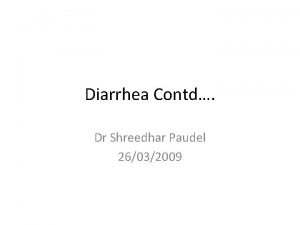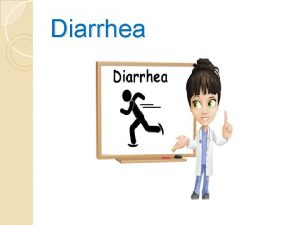Infectious calf diarrhea Definition Definition Calf scours is









































- Slides: 41

Infectious calf diarrhea

Definition: Definition • Calf scours is not a specific disease with a specific cause, but is actually a clinical sign of a disease complex with many possible causes. It mainly develops during the first 30 -50 days of life • Scours occur when normal movement of water into and out of the digestive tract is disrupted, resulting in water loss and dehydration. Loss of body fluids through diarrhea is accompanied by loss of body salts. This fluid and electrolyte loss produces a change in body chemistry that can lead to severe depression in the calf and eventual death.

Etiology: Noninfectious Scours • Calves do best under consistent circumstances. Sudden changes, especially to the feeding program, Overfeeding, switching milk replacer brands or changing from a high to a low quality milk replacer formulation can adversely affect digestion. Ingredient differences, taste, nutrient and product density can affect a calf's willingness to drink as well as its performance. Changes like these should be evaluated and made gradually

Infectious Scours Bacterial Agents 1. Escherichia coli: three group can be identified Enterotoxigenic E. coli, these strains adeher the mucosal surface of intestine and secret four toxins (enterotoxins, sidophores, verotoxins and hemolysin), these strains contain k 99 antigen which play the main role in toxin production. b. Enteropathogenic E. coli, these strain colonize in small intetsine, cause diarrhea and not produce enterotoxins. c. Enterohemorrhagic E. coli, these strains colonize large intesine, cuases mild dysentry. a.

• Clinical signs: • Septicemia: – E. coli septicemia occurs in calves in the first few days of life. – It is characterized by an acute generalized infection, sometimes with diarrhea at the late stage (mucoid feces), with signs of shock (listlessness, poor response to external stimuli, tachycardia, coma), often followed by death (in 3 -8 h with fatality of up to 100%). – In some animal infection become localized causing polyarthritis, pneumonia and meningitis. • Diarrhea: – watery diarrhea followed by dehydration, metabolic acidosis and death. Calve produce large amounts of foul smelling pasty or watery feces varying from pale yellow to white in colour (white scour)and occasionally containing flecks of blood. Loss of body weight, dehydration – In very severe case, calves will collapse, demonstrating weakness, recumbency and hypothermia, progressing to death possibly with convulsions if not treated

E. coli are everywhere in manure-contaminated mud!

Bad conditions > Calf gets mouthful of E. coli!

Low density, no mud > Excellent conditions!

Calving on Winter Feedground High density, lots of manure > Very poor conditions!

2. Salmonella species • The serotypes (serovars) that most commonly cause salmonellosis in farm animal species are as follows: – Cattle: S. typhimurium, S. dublin, Salmonella Newport. – Sheep and goats: S. abortusovis, S. typhimurium, S. dublin, Salmonella anatum

Salmonella Excretion Routes Urine Oronasal Secretions Manure Milk

Bad Practice!

• Clinical signs: • Septicemic form: – It is common in newborn calves and showed high fever (40 -42 °C), depression, dullness and death. Newborn animals that survive from septicemia develop enteritis, polyarthritis and pneumonia. • Acute enteritis – In calves, disease usually occurs between two and six weeks after birth, – Fever follows by diarrhea, which was bloodstained and may contain fibrin and mucus. Eventually, the faeces become dark brown and watery with an offensive odour – The calves become very weak and dehydrated and death usually occurs after five to seven days of illness in untreated individuals.

• Chronis enteritis – This form occurs in adult calves, intermittent fever and intermittent or persistent diarrhea with spots of blood and mucous – The sequel of some case of enteric salmonellosis is the development of ischemia and dry gangrene of extremities including ear lips, tail tips and limbs from the fetlock down • Sheep and goats: • Clinical signs of salmonellosis in sheep are varied and include general systemic and enteric manifestation and abortion (in the last 6 weeks of gestation). • Ewes infected with S. abortus show abortion as the main sign with unnoticeable pyrexia. • S. typhimurium and S. Dublin cause enteric and systemic signs as fever, anorexia, profuse scour, abortion and death due to septicemia or dehydration.

3. Clostridium perfringens Types C & D cause enterotoxemia, an acute intestinal infection, and kill through the production of a systemic toxin. Clostridium perfringens is normally found in the intestine of cattle and can survive for months in the soil. Overeating or sudden change of diet tend to produce indigestion, which slows gut movement, providing the sugars, proteins and lack of oxygen for rapid growth of Clostridium perfringens. Wet conditions also seem to favor this organism Clinical signs: Affected calves show uneasiness and strain or kick at their abdomen. Calves are often found dead without having shown any symptoms Occurance: Usually affects calves less than 10 -14 days of age

• Viral agents: 1. Rotavirus is a new genus within the family Reoviridae. The presence of colostral antibodies against rota virus in lumen of intestine give protection but antibodies in serum does not protect animals against clinical disease Viruses of this type can cause scours in calves within 24 hours of birth. It can affect calves up to 30 days of age or older mainly with 4 -14 days of age. Infected calves are severely depressed. There may be a drooling of saliva and profuse watery diarrhea. The feces will vary in color from yellow to green Abdomen is distended at the right lower quarter with fluid-filled intestine. Calves lose their appetite and the death rate may be as high as 50 percent, depending on the secondary bacteria present

2. Coronavirus: Scours caused by coronavirus occurs in calves that are over 5 days of age. When the infection first starts in a herd, calves up to 6 weeks of age may scour. These calves are not as depressed as those infected with rotavirus. Initially, the fecal material may have the same appearance as that caused by rotavirus. As the calf continues to scour for several hours, however, the fecal material may contain clear mucus that resembles the white of an egg

3. Herpesvirus (infectious bovine rhinotracheitis) Herpesvirus type 1 may causes alimentary disease with mucosal lesion

• Protozoal Agents 1. Coccidia and Cryptosporidia are found in nearly all cattle populations. These organisms enter the body through contaminated feed and water and can lay dormant in manure and soil for up to one year. Once in the intestine, the oocysts (eggs) release protozoa that multiply, attach to and enter the cells of the intestinal lining decreasing digestion and absorption of feed ingredients Clinical signs: animals suffer reduced feed consumption, Acute infections result in diarrhea (often with blood), depression, weight loss, dehydration, but calves will often continue to eat Occurrence: Coccidia have a 21 -day life cycle, so it is unlikely that calves will scour before 18 -19 days of age

Cryptosporidia are typically found in calves from 7 - 21 days of age Cryptosporidia are often detected in combination with rotavirus, coronavirus and E. coli.

Parasitic agents It is a parasitic disease caused by heavy infestation of small intestine by Ascaris worms, it affect calves of 2 -5 months. It characterized by alternative constipation and diarrhea, pot-belly and colic. Signs of bronchopneumonia as cough and dyspnea due to migration of immature worm through liver and lung.

Most Common Infectious Organisms and the Age of Diarrhea Organism Age of Diarrhea E. Coli First 3 days Salmonella Day 5 – 14 Corona Virus Day 3 – 7 Roatvirus Day 3 – 7 Eimeria spp. (coccodiosis) Cryptosporidium parvum (parasite) Day 18 – 19 to 6 months Giardia spp. (protozoa) Day 14 – 21 Day 7 – 21 Most Common Non–Infectious Organisms Under–feeding Over–feeding Selenium deficiency Antibiotic treatment Other oral treatments Unknown causes

Pathobiology: • The common feature of newborn calf diarrhea is the dehydration, which results whether the cause of the diarrhea is infectious or nutritional. Therefore, rehydration by oral and/or parental means is the basis of the treatment of calf diarrhea • In young calves, death caused by diarrhea is mainly attributed to fluid losses, electrolyte imbalances, and increased excretion of water, minerals and nutrients. • The total fecal volume in diarrheic calves may be about 40 times than normal.

• Dehydration is initially due to plasma losses but later is due to fluid loss from extravascular compartments. Severe metabolic changes can occur in calves with diarrhea. If the disease is progressive, the acidosis becomes more severe, lactic acidosis develops because of a reduced ability to utilize lactic acid, and severe hypoglycemia may occur because of a reduced rate of conversion of lactic acid to glucose. If extensive fluids are lost, hypovolemia and shock occur • Hyperkalemia is most common in dehydrated diarrheic calves that are severely acidotic. The potassium moves out of the intracellular space into the extracellular space, resulting in hyperkalemia. The predominant clinical finding is bradycardia (heart rate < 90 bpm) in a dehydrated diarrheic calf. However, hypoglycemia and hyothermia may be associated with bradycardia in a similar calf

Prognosis: It depends on animal conditions, care received and virulence of the causative agent. High percentage of calves will recover with the proper care and treatment.

Diagnosis: A. field diagnosis: 1. History and epidemiology of the disease 2. Clinical signs 3. Postmortem lesions

B. Laboratory diagnosis: Samples: From live animals; feces, rectal swabs, nasal swabs, synovial from infected joint, blood and serum. From dead animals; parts from liver, gall bladder, spleen, brain, kidney, lymphnode especially mesenteric lymphnodes (gall bladder and mesenteric lymphnodes were proved to the predilection sites for isolation for salmonellosis).

Laboratory examinations: Isolation the organism on selective media as Mc. Conkey agar for E. coli, selenit F broth or tetrathionate broth for salmonella or, Virus isolation on cell culture using fecal filtrate or tissue suspension. 2. Serological examination: It has diagnostic value to identify salmonella infected herds, especially carriers. a) ELISA, it can be used for detection of carrier in case of S. Dublin in adult cattle. b) Latex agglutination test; it can be used for identification of S. enteridis. c) Indirect hemagglutination test; it use for detection of salmonella infection in sheep. d) CFT; it can be used for identification of recent S. dublin infection. 1.

3. Serological examination, antigen of K 99 can be done by slide agglutination. Also, ELISA, FAT can be performed on fecal samples. 4. Hematological analysis: leukopenia, neutropenia, and hyperkalemia. 5. A serological test such as ELISA, is the most sensitive test for detection of virus (rota and crona virus) in feces of the infected calve. Besides FAT and immunodiffusion test. 6. Carrier diagnosis (salmonellosis) : The recommended procedures for diagnosis of carriers depends on a combination of fecal culture of all animals at 7 -14 days intervals for 3 examinations and serological examination such as ELISA.

Treatment: 1. Fluid therpy: The fluid therapy is based on isotonic equimolar mixture of sodium and glucose. the hydration treatment on the degree of the dehydration Content Formula 1 Formula 2 Sodium chloride 20 g 25 g Sodium bicarbonate 20 g 4. 5 g Potassium chloride 6 g 3 g Glucose 200 g 130 g water 4 liter 4 liter

The guide of the estimation of the dehydration degree and the corresponding base deficit in the diarrheic calves. Dehydration degree Clinical signs Dehydration (%) Approximate deficit base (m. Eq)* Calf is standing, skin "tents" for 4 1 seconds or less, eyes are bright, 5 5 7 10 9 15 oral membranes are moist. Calf is dull and lying down but upright, 2 3 skin "tents" for 5 seconds, eyes are sunken slightly with a slight gap, limbs are cold, oral membranes are warm Calf is lying flat in a coma, skin stays "tented", eyes are deeply sunken with a big gap, limbs are cold, oral membranes are cold * Per liter of extra-cellular fluid volume of hydration therapy is 40 kg x 7%= 2. 8 liters of fluid plus allowance for maintenance requirements (minimum of 100 ml/kg/day). The maintenance requirements for a 40 kg calf are 40 kg x 100= 4 liters fluid. Therefore, total volume of fluid should be given over 3 feedings.


Bicarbonate should not be added to solutions containing calcium, such as Lactated Ringer's Solution, as a precipitate may form. Bicarbonate may be added to saline solutions. Lactated ringer’s solution is the best treatment for calves with severe dehydration and metabolic acidosis. Physiological (0. 9%) saline with up to 5 gm Na. HCO 3, 50 gm glucose/liter

Milk feeding to calves with diarrhea is still debated, but evidence is accumulating that feeding milk to a calf with diarrhea is unlikely to negatively affect outcome. On the other hand, withholding milk from calves with coronavirus, cryptosporidiosis or salmonella over the long period it takes for the diarrhea to resolve may result in the calf starving to death. Digestion and absorption of milk or milk replacer may be maximized in diarrheic calves by feeding smaller but more frequent milk meals. If bicarbonate-containing oral electrolyte solutions are also being used, they should be given at least 30 to 60 minutes after a milk meal to minimize their disruption of milk digestion

Gut protectants or adsorbents such as Koalin. Pectin or Bismuth salts are sometimes used as adjunct therapy for diarrhea. Kaolin-pectin, while it may improve the character of the stool, has not been shown to improve fluid and electrolyte imbalances Hypothermia can be a significant problem in diarrheic calves. Oral and intravenous fluids should be warmed to target body temperature before administration. Calves with severe hypothermia may be most effectively warmed by submersion in a warm water bath

probiotics: Probiotics supplement the intestinal flora with viable beneficial bacteria and thus create unfavorable conditions for the growth of enteropathogens, reduce the occurrence of scours, and are rather a complementary therapy for resorting balance to intestinal flora. The currently available probiotics contain strains of lactobacillus and streptococcus spp. The minimum effective dose is 108 -109 CFU/calf/day.

Immunoglobulins: Gut acting immunoglobulins is one of the most recent methods of treatment of diarrhea. Immunoglobulins prepared in egg yolk (Ig. Y) against enteropathogens can be used as immunotherapy or prophylactic against intestinal organisms. 6. Supportive treatment: It includes astringents and adsorbents (antidiarrhea), parasympatholoytics and spasmolytics to counteract the hyperperistalsis of the intestine.

Control: Reduction of the degree of exposure of newborn calves to infectious agents: Proper housing and management of calves: Calves should be born in well bedded clean hygienic calving boxes. Overcrowding should be avoided, individual pen for each calf or 8 calves of approximately of equal age in one unit. The ground of the pens should be of suitable slopping to permit good drainage and they should be disinfected periodically once a week. Feeding and water utensils should be placed away from fecal contamination and should be cleaned and disinfected after each use. Immediately after birth the umbilicus of the calf should be swabbed with 2% iodine. Calves affected with diarrhea should be removed from the main calf barn if possible and treated in isolation and don’t return back to group of calves at risk (>30 days of age). Prophylactic medication with antibiotic or sulfonamides for first week of life, injection of Vit A, blood or serum transfusion can be applied if necessary.

Proper housing and management of dams Dams should be placed in good hygienic house with calving pens. Dams should received good balanced ration. Movement of heavy pregnant dam should be avoided. Prepartum milking should be avoided. The perineum and udder of the dairy cow should be washed shortly before calving.

Provision of maximum non specific resistance: Optimal nutrition to the pregnant dam should be give in order to obtain a vigorous newborn animal and adequate quantities of colostrums. Calves should early receive colostrums (50 ml/kg in the first 2 hours of life). Natural suckling of colostrums from the udder is better than bucket feeding (calf is able to stand within 20 minutes after birth and able to suck after 3 hours of birth). The level of the serum immunoglobulins can be estimated by zinc sulfate turbidity test at 24 hours of age. Calves show low serum immunoglobulin level should receive purified bovine immunoglobulins as 30 -50 g inoculated intravenously, The alternative way is feeding of fermented colostrums for up to 3 weeks of age to elevate the lactoglobulin in the intestinal tract, which reduces the incidence of diarrhea. Stress factors should be avoided with adequate housing area and good ventilation.

Increasing specific resistance of the newborn by vaccinating the pregnant dam or the newborn: The immunization of neonate farm animals against colibacillosis by vaccination of the pregnant dam or by vaccination of the neonate. Vaccination is aid to the good management, but can not compensate the inadequate management
 Mebosha
Mebosha Nicholas seeliger, md flpen 32413
Nicholas seeliger, md flpen 32413 Diarrhea plan a
Diarrhea plan a Spinal reflexology
Spinal reflexology Radwan
Radwan What is bile acid diarrhea
What is bile acid diarrhea Infectious disease quality controls
Infectious disease quality controls Types of infection
Types of infection Types of diarrhea
Types of diarrhea Diarrhea plan a
Diarrhea plan a Causes of secretory diarrhea
Causes of secretory diarrhea Zinc for diarrhea
Zinc for diarrhea Osmotic diarrhea meaning
Osmotic diarrhea meaning Secretory diarrhea
Secretory diarrhea Chapter 26 infectious disease prevention and control
Chapter 26 infectious disease prevention and control Pig diarrhea chart
Pig diarrhea chart Overflow diarrhea
Overflow diarrhea Diarrhea
Diarrhea Liemyosarcoma
Liemyosarcoma Imci color coding
Imci color coding Stages of infectious disease
Stages of infectious disease Hiv stool color
Hiv stool color Diarrhea chief complaint
Diarrhea chief complaint Dr ali azzam
Dr ali azzam Infectious canine hepatitis in dogs
Infectious canine hepatitis in dogs Stridor
Stridor Certain infectious and parasitic diseases
Certain infectious and parasitic diseases Smallest infectious agents
Smallest infectious agents Infectious canine hepatitis in dogs
Infectious canine hepatitis in dogs Infectious nucleic acid
Infectious nucleic acid Leishmania donovani transmission
Leishmania donovani transmission Infectious mononucleosis
Infectious mononucleosis Infectious disease
Infectious disease Diarrhea
Diarrhea Travelers diarrhea
Travelers diarrhea Git normal flora
Git normal flora Diarrhea introduction
Diarrhea introduction Ebv
Ebv Hennepin county infectious disease manual
Hennepin county infectious disease manual Epidemiological triad
Epidemiological triad Traumacal
Traumacal Why does metformin cause diarrhea
Why does metformin cause diarrhea
